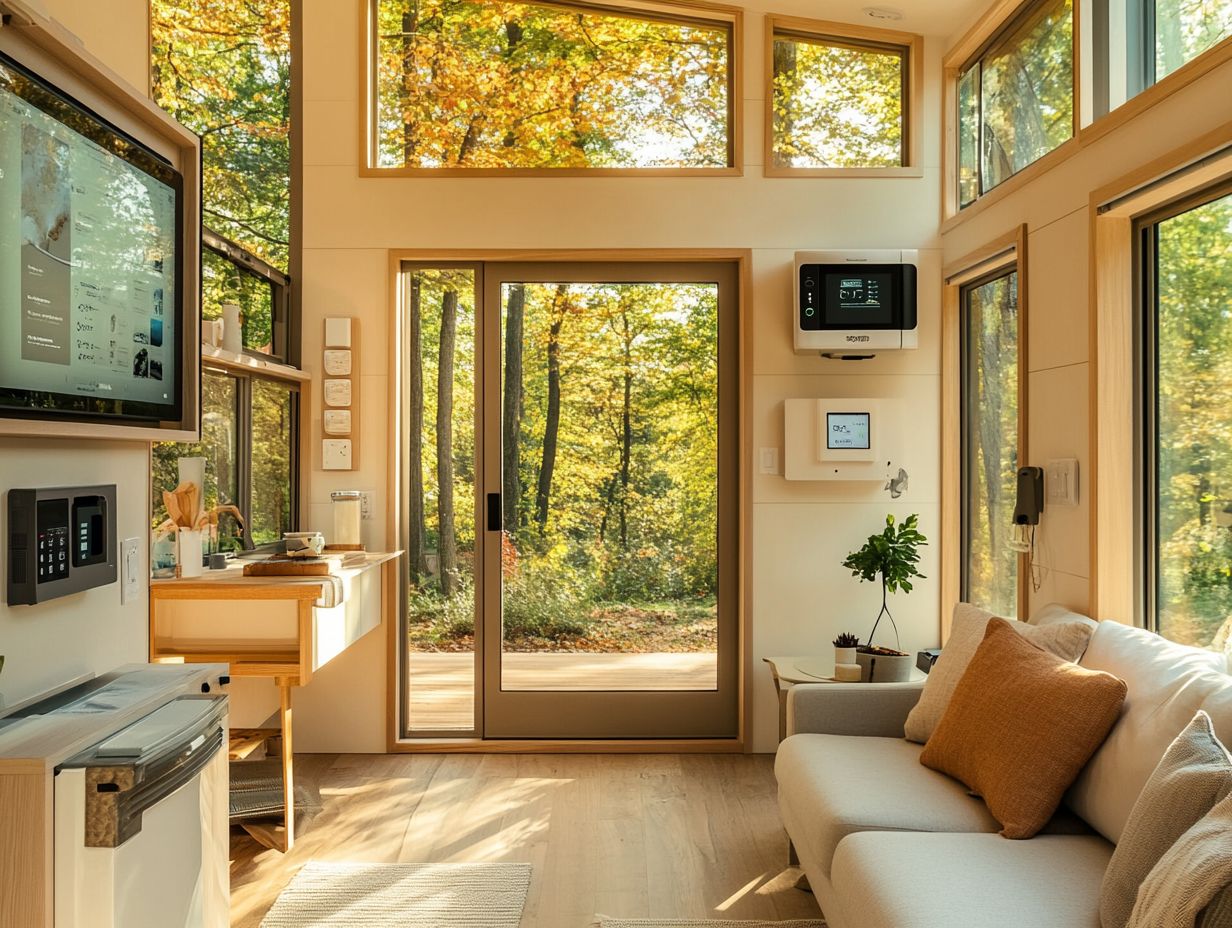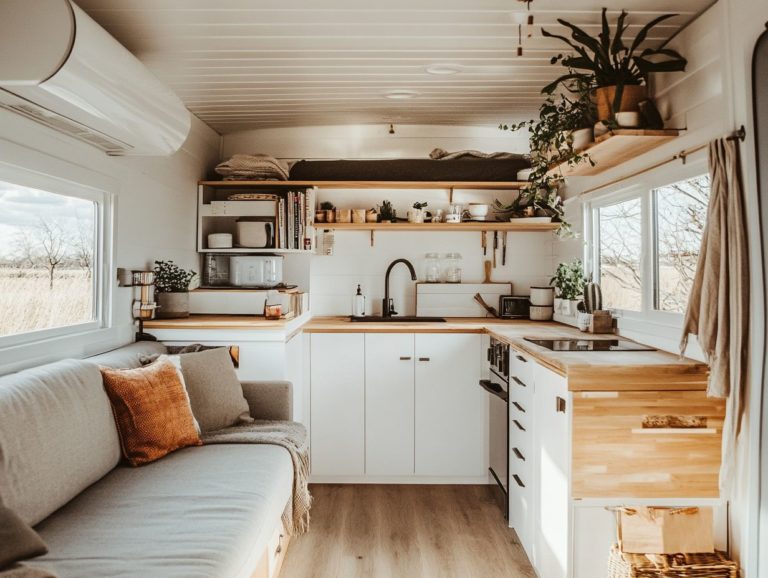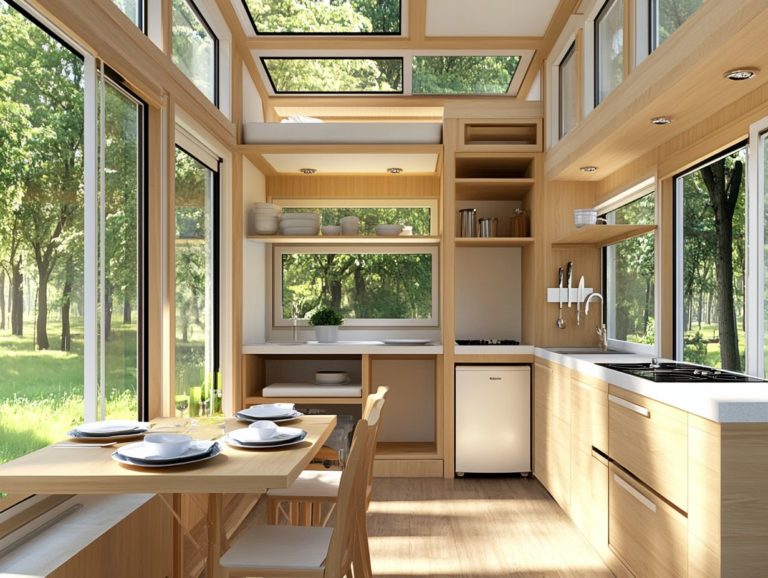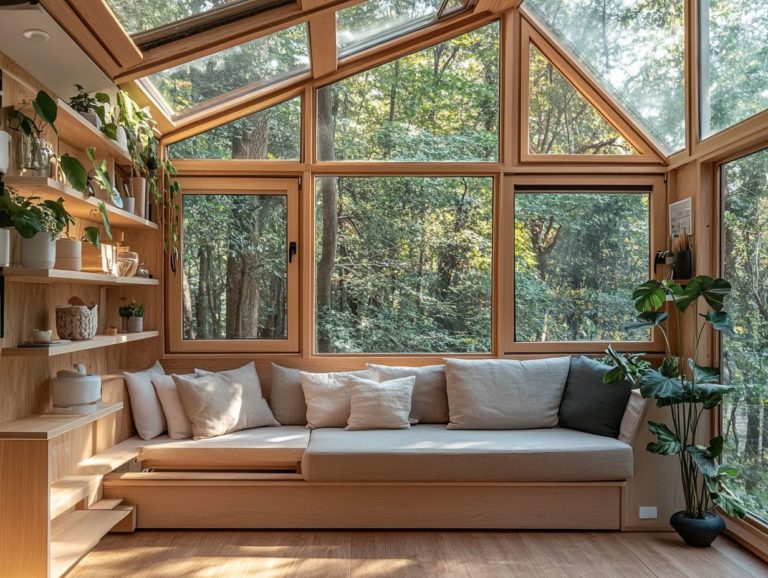How to Use Technology for Tiny Home Efficiency
Tiny homes transcend mere trendiness; they embody a transformative approach to sustainable and efficient living.
In small spaces, optimizing every square inch becomes paramount. This article delves into cutting-edge technologies that boost energy efficiency, such as solar panels and smart home systems. It also showcases how multifunctional furniture and intelligent storage solutions can maximize your available space.
You will explore sustainable living options, including composting toilets and greywater systems, a method to recycle water from sinks and showers. Before embarking on this journey, we will discuss essential considerations like cost and maintenance, empowering you to make informed decisions as you navigate the world of tiny homes.
Contents [hide]
- Key Takeaways:
- Technologies for Energy Efficiency
- Technologies for Space Optimization
- Technologies for Sustainable Living
- Considerations Before Implementing Technology
- Frequently Asked Questions
- How can using technology improve the efficiency of a tiny home?
- Looking for tools to manage your tiny home? Here s what you can use!
- How can smart thermostats help with tiny home efficiency?
- Are there apps designed for managing a tiny home?
- Can technology help with space-saving in a tiny home?
- Is it expensive to incorporate technology into a tiny home?
Key Takeaways:

- Implementing solar panels and other alternative energy sources can greatly reduce energy costs and make your tiny home more eco-friendly.
- Investing in smart home systems and multifunctional furniture can help maximize the limited space in a tiny home, making daily tasks more convenient and efficient.
- Sustainable living practices, such as composting toilets and greywater systems, can decrease your ecological footprint and contribute to a more self-sufficient lifestyle in a tiny home.
What is a Tiny Home and Why Optimize Efficiency?
Tiny homes crafted by No Boundaries Tiny Homes, an architectural salvage company in Eau Claire, Wisconsin, embody a transformative approach to housing. They champion efficiency, sustainability, and minimalism.
By embracing custom tiny home designs and architectural salvage techniques, these residences are not merely compact; they are also eco-friendly, playing a vital role in significant green initiatives aimed at reducing environmental impact.
The inclusion of energy-efficient technologies and sustainable materials, such as bamboo flooring, sheep’s wool insulation, and repurposed materials, heightens their allure for those who prioritize health and wellness benefits while striving to live in harmony with nature.
This movement toward tiny living invites you to reassess your priorities, encouraging a focus on experiences rather than an accumulation of possessions. The minimalist lifestyle adopted by tiny home residents alleviates financial burdens and fosters a deeper connection with their surroundings, paving the way for a simpler yet more fulfilling existence.
The emphasis on green building practices attracts innovative tiny home builders dedicated to creating spaces that seamlessly blend function and form. As a result, these efficient designs not only optimize energy consumption but also enhance mental well-being by fostering calming, clutter-free environments that resonate with tranquility. For those interested in further improving their tiny homes, making a tiny house more energy efficient can be a valuable consideration.
Technologies for Energy Efficiency
Technologies that promote energy efficiency are essential for enhancing the sustainability of tiny homes. By integrating these advancements, you can significantly reduce your environmental footprint while still enjoying the modern conveniences that make life comfortable.
Solar Panels and Alternative Energy Sources
Solar panels have emerged as a top choice for tiny homes, allowing you to harness renewable energy while reducing your dependence on traditional power grids.
This approach dramatically cuts your energy bills and aligns perfectly with the sustainable lifestyle many tiny home enthusiasts cherish. By investing in solar and incorporating smart home tech, you can significantly lower your carbon footprint and help foster a cleaner environment.
Combining solar panels with alternative energy sources like wind turbines or geothermal heating can enhance your energy system’s resilience and efficiency. For instance, when solar energy dips during the winter months, a supplementary wind turbine can step in to provide the necessary power. This illustrates how modern living can seamlessly integrate various energy-efficient technologies to elevate sustainability to new heights.
Ready to embrace tiny living? Start your journey now!
Smart Home Systems
Smart home systems are transforming how you interact with your living spaces, making tiny homes more efficient and user-friendly thanks to cutting-edge technology.
These innovations are essential for managing energy consumption and optimizing resource usage. Tools like smart thermostats and energy-efficient lighting play a key role in this. Automated climate control systems adjust temperatures based on who s home and the weather, significantly cutting down on energy waste. You can even program smart appliances to operate during off-peak hours to help lower your energy bills.
By integrating smart technologies, you can effortlessly monitor and adjust your energy usage, supporting a lifestyle that values sustainability. Additionally, incorporating smart home technology in tiny houses makes tiny living not just more convenient but also contributes to a greener planet through eco-friendly practices.
Technologies for Space Optimization

In tiny homes, space optimization is not just a necessity; it s an art form. Embracing innovative technologies like furniture that serves multiple purposes and smart storage solutions allows you to maximize every inch while maintaining style and functionality.
Multifunctional Furniture
Furniture that serves multiple purposes transforms tiny home design, offering versatile solutions that maximize your limited space without sacrificing aesthetic appeal.
These innovative pieces often serve dual or even triple purposes. Imagine a sofa bed that seamlessly converts into a workspace or a coffee table that cleverly conceals hidden storage. The collaboration between builders and furniture designers plays a crucial role, crafting bespoke solutions that address the unique challenges of compact living.
Designers use smart engineering and creativity to ensure that functionality never compromises style. The result is elegant yet practical furnishings that elevate your overall living experience. This synergy enhances livability in small spaces and reflects a lifestyle that embraces simplicity and resourcefulness.
Smart Storage Solutions
Smart storage solutions are crucial for tiny homes, enabling you to make the most of every square foot while maintaining a clutter-free living environment.
These designs often feature furniture that serves multiple purposes, like beds with built-in drawers or coffee tables that transform into workspaces. Tiny home builders are increasingly embracing vertical storage options, such as wall-mounted shelves and hanging organizers, ensuring that every nook and cranny serves a purpose.
Hidden compartments in staircases or under-vehicle storage options provide extra room for your belongings while keeping the aesthetic intact. By thoughtfully planning layouts and employing creative storage solutions, designers tackle space limitations and encourage a minimalist lifestyle that resonates with you.
Technologies for Sustainable Living
Technologies that enable sustainable living in tiny homes, like composting toilets and greywater systems, empower you to embrace eco-friendly practices while enjoying high comfort levels.
These innovations blend environmental responsibility with modern convenience, allowing you to thrive in a smaller footprint without compromising on quality of life.
Composting Toilets
Composting toilets offer a remarkable solution for tiny homes, providing a sustainable alternative to traditional plumbing and dramatically reducing water usage.
These systems work by naturally breaking down waste, transforming it into compost that enriches soil. The environmental benefits are substantial; they divert waste from landfills and reduce reliance on municipal sewage treatment, which often contributes to energy consumption and pollution. By embracing these toilets, you align with sustainability principles, adopting a lifestyle that prioritizes eco-consciousness.
They become an integral part of green living, conserving precious resources while deepening your connection with nature in compact, off-grid spaces.
Greywater Systems

Greywater systems offer a sophisticated way to reuse water from sinks and showers, enhancing the sustainability of your tiny home. By capturing and filtering this wastewater, you can irrigate your garden or flush your toilets, significantly reducing your reliance on municipal water supplies.
In the realm of tiny living, where every resource is precious, adopting a greywater system not only makes the best use of water but also deepens your engagement with essential sustainability practices. These systems can lower your water bills dramatically and promote responsible consumption, making them a perfect fit for those committed to a minimalist yet fulfilling lifestyle.
As tiny homes continue to gain traction, grasping and implementing greywater recycling solutions becomes an essential step toward fully embracing a more sustainable way of living.
Considerations Before Implementing Technology
Before you dive into implementing various technologies in tiny homes, it s crucial to weigh factors like cost, maintenance, and compatibility.
These considerations will help you create a successful and sustainable living experience that truly meets your needs.
Cost, Maintenance, and Compatibility
Understanding the cost, maintenance requirements, and compatibility of various technologies is essential for you as a homeowner aiming to optimize your tiny living space effectively.
As you navigate the complexities of downsizing, you encounter unique challenges in incorporating modern conveniences without overwhelming your limited square footage.
Budget constraints often guide your choice of energy-efficient appliances and smart home systems, allowing you to enhance comfort while keeping long-term costs in check.
If you re a tiny home builder, consider logistics like ensuring an adequate power supply, finding space for solar panels, and checking compatibility with existing home systems.
These financial and logistical factors significantly shape your decisions, ultimately influencing the functionality and sustainability of your tiny living space.
Frequently Asked Questions
How can using technology improve the efficiency of a tiny home?
Technology can help improve the efficiency of a tiny home by automating tasks, monitoring energy usage, and controlling temperature and lighting.
Looking for tools to manage your tiny home? Here s what you can use!

Some examples include smart thermostats, energy-efficient appliances, solar panels, and home automation systems.
How can smart thermostats help with tiny home efficiency?
Smart thermostats can help regulate the temperature in a tiny home, ensuring that energy is not wasted on heating or cooling when it is not needed.
Are there apps designed for managing a tiny home?
Yes, there are apps available that can help with tasks such as monitoring energy usage, managing home automation systems, and tracking maintenance schedules.
Can technology help with space-saving in a tiny home?
Yes, there are many space-saving technologies available, such as foldable furniture, compact appliances, and ingenious storage solutions that can help maximize limited space in a tiny home.
Is it expensive to incorporate technology into a tiny home?
It can be costly to initially set up technology in a tiny home, but in the long run, it can save money on energy bills and improve overall efficiency, making it a worthwhile investment.






